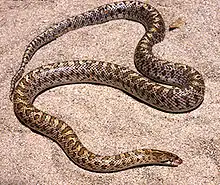Glossy snake
Arizona elegans is a species of medium-sized colubrid snake commonly referred to as the glossy snake or the faded snake,[3] which is endemic to the southwestern United States and Mexico. It has several subspecies. Some have recommended that A. elegans occidentalis be granted full species status.
| Glossy snake | |
|---|---|
 | |
| Arizona elegans occidentalis | |
| Scientific classification | |
| Kingdom: | Animalia |
| Phylum: | Chordata |
| Class: | Reptilia |
| Order: | Squamata |
| Suborder: | Serpentes |
| Family: | Colubridae |
| Genus: | Arizona |
| Species: | A. elegans |
| Binomial name | |
| Arizona elegans | |
| Synonyms | |
Subspecies
Subspecies of Arizona elegans include:
- Arizona elegans arenicola Dixon, 1960 — Texas glossy snake
- Arizona elegans candida Klauber, 1946 — Western Mojave glossy snake
- Arizona elegans eburnata Klauber, 1946 — Desert glossy snake
- Arizona elegans elegans Kennicott, 1859 — Kansas glossy snake
- Arizona elegans expolita Klauber, 1946 — Chihuahua glossy snake
- Arizona elegans noctivaga Klauber, 1946 — Arizona glossy snake
- Arizona elegans occidentalis Blanchard, 1924 — California glossy snake[4]
- Arizona elegans philipi Klauber, 1946 — Painted Desert glossy snake
Description
The glossy snake and its many subspecies are all similar in appearance to gopher snakes. However, they are smaller than gopher snakes, with narrow, pointed heads, and a variety of skin patterns and colors. They appear "washed-out" or pale, hence the common name, "faded snakes".[5]
Most subspecies are ca. 75–130 cm (ca. 30-50 inches) in total length. The maximum recorded total length for the species is 142 cm (56 in).[6]
They are shades of tan, brown, and gray with spotted patterns on their smooth, glossy skin, and a white or cream-colored unmarked ventral surface. Coloration often varies in relation to the color of the soil in a snake's native habitat.
Habitat

Habitat is normally semi-arid grasslands of the southwestern United States, from California in the west to Kansas in the east and as far south as Texas, and northern Mexico.
Behavior and diet
They are nonvenomous, nocturnal predators of small lizards. They are also sometimes found in attics.
Reproduction
Glossy snakes are oviparous. Adults breed in the late spring and early summer. Clutches average from 10 to 20 eggs. The eggs hatch in early summers and the newly hatched young are approximately 25 cm (9.8 in) in total length.
References
- Hammerson, G.A., Frost, D.R., Santos-Barrera, G., Vasquez Díaz, J. & Quintero Díaz, G.E. 2007. Arizona elegans. The IUCN Red List of Threatened Species 2007: e.T63734A12711788. https://dx.doi.org/10.2305/IUCN.UK.2007.RLTS.T63734A12711788.en. Downloaded on 12 October 2018.
- The Reptile Database. www.reptile-database.org.
- Schmidt, K.P., and D.D.Davis. 1941. Field Book of Snakes of the United States and Canada. G.P. Putnam's Sons. New York. 365 pp. (Arizona elegans, pp. 155-158, Figures 43. & 44. + Plate 17.)
- CaliforniaHerps.com: Arizona elegans occidentalis . accessed 8.28.2013
- Conant, R. 1975. A Field Guide to Reptiles and Amphibians of Eastern and Central North America, Second Edition. Houghton Mifflin. Boston. 429 pp. ISBN 0-395-19977-8 (paperback). (Arizona elegans, pp. 197-198 + Plate 27 + Map 145.)
- Smith, H.M., and E.D. Brodie, Jr. 1982. Reptiles of North America: A Guide to Field Identification. Golden Press. New York. 240 pp. ISBN 0-307-13666-3 (paperback). (Arizona elegans, pp. 182-183.)
Further reading
- Kennicott, R. in Baird, S.F. 1859. United States and Mexican Boundary Survey, under the Order of Lieut. Col. W. H. Emory, Major First Cavalry, and United States Commissioner. Reptiles of the Boundary, with Notes by the Naturalists of the Survey [Volume 2]. United States Government. Washington, District of Columbia. 35 pp. + Plates I.- XLI. (Arizona elegans, pp. 18–19 + Plate XIII.)
- Klauber, L.M. 1946. The Glossy Snake, Arizona, with Descriptions of New Subspecies. Transactions of the San Diego Society of Natural History 10 (17):311-398.
External links
| Wikimedia Commons has media related to Arizona elegans. |
- "Arizona elegans". Integrated Taxonomic Information System. Retrieved 6 February 2006.
- Species Arizona elegans at The Reptile Database
